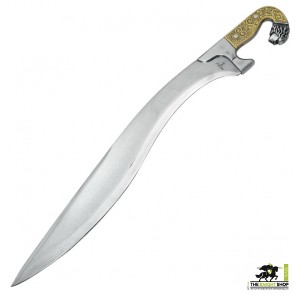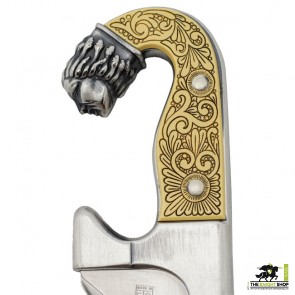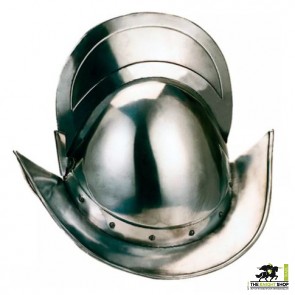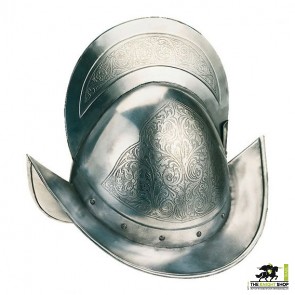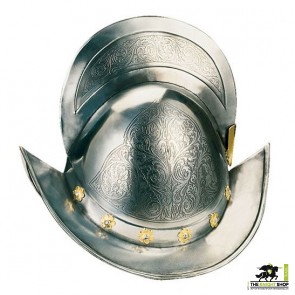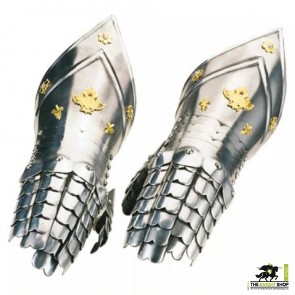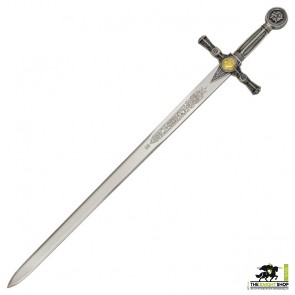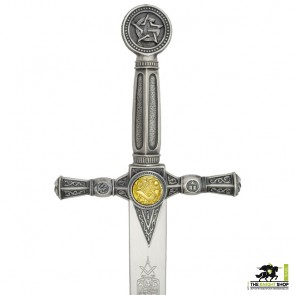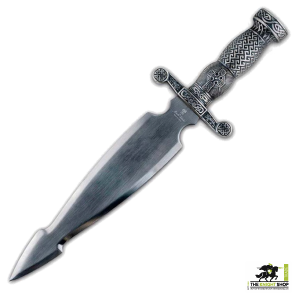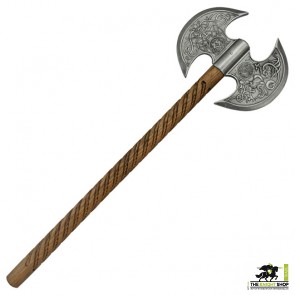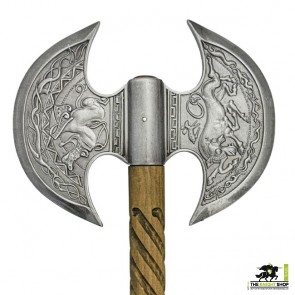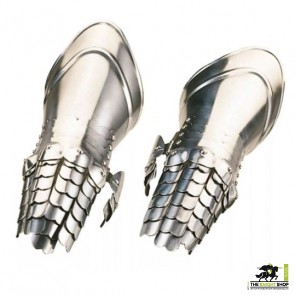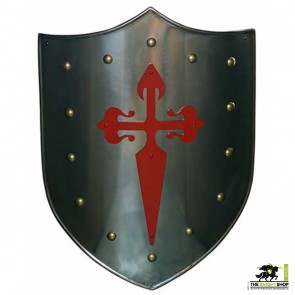Catalog Advanced Search
199 item(s) were found using the following search criteria
- Brand: Marto
Don't see what you're looking for? Modify your search
-
Iberian Falcata - Silver
The falcata is a type of weapon, a sword of steel originated in Iberia, and therefore related to the Iberian native populations before the Roman conquest. It was used by the Iberian countries or neighbors like the Celtiberians being the most common sword in the area of the peninsula. Roman chroniclers praised the quality of the iron that was used for the construction of the Hispanic weapons; they were surprised by its cutting ability and flexibility, one of the most prized and sought features in its manufacture.
Learn More
As a curious note, reflecting the effectiveness of these weapons, after the first battles in the Iberian Peninsula, an order was given to Roman troops to reinforced with iron the edges of their shields, possibly due to the cutting power of the falcatas, much higher than the straight swords and sabers.
Total length: 60 cm
Blade length: 50 cm
Grip length: 10 cm
Weight: 1.5 kg
Blade: Stainless Steel
Edge: Blunt
Scabbard: None
All dimensions are approximate and may vary from piece to piece. -
Spanish Morion Helmet
The Conqueror Helmet is a type of open helmet used from the middle 16th and early 17th centuries, usually having a flat brim and a crest from front to back. Its introduction was contemporaneous with the exploration of North, Central, and South America.
Learn More
Explorers like Hernando de Soto and Coronado may have supplied them to their foot soldiers in the 1540s. The iconic morion is popularly identified with early Spanish explorers and conquistadors. No inner padding included.
Height: 33cm
Circumference: 60cm
Weight: 1472g
Material: Iron Steel Plate
All dimensions are approximate and may vary from piece to piece.
Buy the Helmet with confidence from the UK’s leading Medieval Helmet retailer. -
Spanish Etched Morion Helmet
The Conqueror Helmet is a type of open helmet used from the middle 16th and early 17th centuries, usually having a flat brim and a crest from front to back. Its introduction was contemporaneous with the exploration of North, Central, and South America.
Learn More
Explorers like Hernando de Soto and Coronado may have supplied them to their foot soldiers in the 1540s. The iconic morion is popularly identified with early Spanish explorers and conquistadors. No inner padding included.
Height: 33cm
Circumference: 60cm
Weight: 1472g
Material: Iron Steel Plate
All dimensions are approximate and may vary from piece to piece.
Buy the Helmet with confidence from the UK’s leading Medieval Helmet retailer. -
Spanish Etched Morion Helmet - Gold
The Conqueror Helmet is a type of open helmet used from the middle 16th and early 17th centuries, usually having a flat brim and a crest from front to back. Its introduction was contemporaneous with the exploration of North, Central, and South America.
Learn More
Explorers like Hernando de Soto and Coronado may have supplied them to their foot soldiers in the 1540s. The iconic morion is popularly identified with early Spanish explorers and conquistadors.
This helmet comes with 24K Gold plated floral motifs which gives it an eye-catching appeal as a display piece. No inner padding included.
Height: 33cm
Circumference: 60cm
Weight: 1472g
Material: Iron Steel Plate
All dimensions are approximate and may vary from piece to piece.
Buy the Helmet with confidence from the UK’s leading Medieval Helmet retailer. -
Decorated Gauntlets
Our 16th Century Spanish Gauntlets by Marto have separate and articulated fingers and are typical of the Spanish armory of the 16th century. These Gauntlets are made in steel and enriched with 24K Gold plated metal figures applied on the back.
Learn More
In the fourteenth century, the fingers were separated, until the middle of the sixteenth century in order to fire the pistol grip. In many tournament armors of the fifteenth and early sixteenth century the left hand had mittens of fingers separated and the right hand, for the spear, defended by a mitten.
Length: 40cm
Weight: 1600g
All dimensions are approximate and may vary from piece to piece.
Buy the Gauntlets with confidence from the UK’s leading Medieval armour retailer. -
Masonic Cadet Sword
FREEMASONRY: “a philanthropic, institution intended to achieve an understanding of truth, the study of ethics and the practice of solidarity, working for the material and moral improvement of humanity, it is compatible with any religious or esoteric faith which does not annul the freedom of individuals”. Starting from the tradition of builders harking back to the “medieval masons and architects” freemasonry pursues the personal self-construction of the individual.
Learn More
This unique sword contains a great many of the symbols used in the craft, particularly the compass and set square, the plumb line and the hammer, the sacred book and the eye of the Supreme Being, and the five-pointed star inscribed in the capital “G” of the Great.
Total length: 75cm
Weight: 2.1kg
Blade: AISI 440 Tempered Stainless Steel
Edge: Blunt
Scabbard: None
All measurements are approximate and will vary from piece to piece. -
Celtic Dagger
The Celtic people lived during the Iron Age, dominating most of western and central Europe. They decorated their weapons handles with precious stones, ivory, or enamel. They adorned the swords and helmets with original human figures or animal heads. The weapons were almost sacred to the ancient Celts. One for the battlefield, more sober and functional, and another ceremonial, much more elaborate.
Learn More
Overall Length: 36cm
Blade: Tempered Stainless Steel
Weight: 400g
Edge: Blunt
All dimensions are approximate and may vary from piece to piece. -
Viking Ceremonial Axe
Perhaps the most common hand weapon among Vikings was the axe. This beautiful axe has a solid-wood shaft, decorated with a spiral pattern, while the axe-blade has a double-head and is embellished with ornately decorative designs. Simple in its form but highly decorated, this axe is the ideal collector's piece that shows off both the axes simplistic shape, as well as beautiful eye-catching features.
Learn More
Length: 60cm
All dimensions are approximate and may vary from piece to piece. -
Smooth Gauntlets
The gauntlets or mittens were part of the armor worn by knights of medieval times. They were metal gloves they used to protect their fingers, hands, wrist area and part of the forearm in the bloody battles of the time.
Learn More
During the 11th and 12th centuries, it consisted of a simple mesh bag with an opening in the fist to reach out the hand. They became leather gloves with an iron rounder over the back and mesh gloves that were buttoned on the sleeve. In the fourteenth century, the fingers are separated, until the middle of the sixteenth century in order to fire the pistol grip.
In many tournament armors of the fifteenth and early sixteenth century the left hand had mittens of fingers separated and the right hand, for the spear, defended by a mitten.
Length: 40cm
Weight: 1600g
All dimensions are approximate and may vary from piece to piece.
Buy the Gauntlets with confidence from the UK’s leading Medieval armour retailer. -
Red St. James Cross Shield
Exquisitely handcrafted in stainless steel with a polished. This finish is a truly intriguing piece of memorabilia. At the shields heart is a red Santiaguist or Santiago Cross. The Order of Santiago also known as "The Order of St. James of the Sword," was founded in the 12th century, and owes its name to the Patron Saint of Spain. In heraldry, the Cross of Saint James also called the Santiago cross or the Cruz espada, is a charge in the form of a cross.
Learn More
The red sword-cross known as the "Cross of St James" is represented as a red cross Flory or flowered cross over a white field, where the shape of the cross is actually the blade of a sword. The military red cross of St James of Compostela is one of Galicia's oldest national symbols and can often be found in Galician heraldry and iconography.
The triangular shield, known as a kite shield, is double reinforced steel with triple reinforced corners. Beautifully embellished detailing of riveted golden studding and red emblem against a natural steel finish adds to the stunning contrast which makes this shield so exquisite.
Comes with an attached hanging chain on the back which allows for easy wall mounting.
Height: 63cm
Width: 43cm
Weight: 3.2kg
All dimensions are approximate and may vary from piece to piece.




